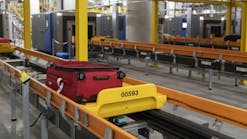Handling the Future: How Conveyance and Security Will Drive Airport Expansion and Improvement
Smart conveyor systems are playing an increasingly pivotal role in the daily operations and projected expansion of the commercial airport baggage- and cargo-handling market. This market is projected to grow at a compound annual growth rate of 7.5 percent from 2016 to 2021 due to the increase in air traffic and modernization of airports.
The main source of growth in this market is derived from the construction of new airport terminals and the expansion of existing facilities across the globe. This anticipated growth is directly tied to projections from the International Air Transport Association (IATA) that forecast the total number of airline passengers will reach 3.91 billion this year, an increase of 930 million passengers since 2012.
Airport professionals are looking for ways to optimize material-handling operations in order to keep up with the growth.
Trends and Challenges
With this growth as the major catalyst, industry professionals strive to make conveyor systems more efficient, while also addressing passenger demands for online baggage tracking, and the increasing need for worldwide security for carry-on and checked bags as well as other types of scanning (i.e. packages). These needs will require decision-makers to consider more sophisticated technologies in baggage handling and security/tracking.
One of the major disruptive trends is the advent of online tracking that enables a passenger to track a bag all the way from drop-off to pick-up. Delta, American Airlines and Lufthansa currently offer online baggage tracking and more airlines are adopting this feature as passengers request more visibility and real-time data regarding their bags.
As rules change surrounding what passengers can pack in carry-on bags, and as airlines increase the costs associated, passengers are demanding increased accuracy and more timely delivery of their bags. Similar to trends in the ecommerce industry, the growing need for higher throughput and higher accuracy causes a change in the way goods are being handled and in this case, how airports are being built.
Installing smarter conveyor systems with advanced scanning features to reduce slippage helps improve the ability to effectively track checked bags and help resolve passenger worry; this instills confidence that checked bags will be delivered in a timely fashion and without damage.
In conjunction with improving baggage tracking processes, airport modernization efforts are improving the design of its check-in counters. As the first stop in the baggage-handling journey, airports are looking to install advanced conveyor and motor systems in the check-in counters, in order to increase efficiency and incur less maintenance fees, less downtime and operating costs throughout the entire process.
Handling Security Matters
As rumors of eliminating all laptop carry-ons persist, security continues to be a major issue that affects how airports treat carry-on luggage and therefore how passengers prepare for travel.
When updating baggage-handling systems, it is also necessary to assess security checkpoints to ensure that intelligent scanner systems are in place. Many companies involved in baggage handling components and technology are also involved in carry-on checking and scanner systems.
Because technology continues to improve in its detection capabilities, including new systems that can better detect types of liquid and gels, it is important to assess new solutions for integration, especially during airport remodel and modernization. Such automated technical solutions may help eliminate persistent carry-on fears and also ensure travels adhere to the proper safety guidelines. Many countries that have legislated a draconian carry-on policy haven’t employed the latest scanning technology. This will exert pressure in several directions.
First, global scanning manufacturing will likely develop upgrades fairly quickly in order to capture this market. Second, airport facilities in higher security zones will ultimately not want to restrict incoming passengers for laptop and other security concerns and will take major efforts to upgrade to more efficient scanning equipment.
Facility decision makers and system integrators will need to integrate systems that will handle increasing throughput, reduce costs, and enable them to negotiate the changing global security landscape.
Global Solutions
Today’s air travel is not as simple as it was two decades ago, with the increased complexity of multiple security threats for both passenger and freight aircraft, the latter of which is growing at a significant rate and requires as much or more conveyance, scanning and checking than the baggage scenario. This demand drives important considerations for both incoming and outgoing cargo.
Supplier consolidation is one major consideration. As airports are responsible for all incoming baggage/cargo, working with a single supplier enables better, more efficient overall service to manage inventory, spare parts and maintenance, decreasing the likelihood of downtime and undelivered or delayed delivery of baggage or freight.
That, of course, is no substitute for installing and maintaining durable equipment. Interroll, for example, has a curve belt at LAX that’s been in service for more than 55 years, without any unplanned downtime, utilizing the company’s routine maintenance. With airport space a costly premium at most facilities, repairs in restrictive spaces are often not easy, reaffirming the need for durability and reliability.
Major improvements in belt curve design, one component integrated into complete baggage- and freight-handling systems, offer some solutions. First, increasing the speed at which the belt curve operates can improve throughput, a major advantage for airports that need to accommodate more and more travelers, while maintaining high security screening levels.
Second, improving belt curve durability dramatically reduces downtime, enhancing traceability and making increased reliability of baggage delivery more achievable for airline companies and reducing penalties associated with delivery delays. That reliability and durability hinges on making a critical decision in choosing between traditional belt-curve friction drive and positive drive. Positive drive requires significantly less maintenance and reduces failures, increasing durability and uptime.
Some standardization between airlines and airports is paramount. Global consultants have a strong and influential role in decision making, particularly at major airports. It’s becoming common practice for major global suppliers to not only supply the equipment but to offer service packages as well, driving what’s becoming a more integral, multifaceted transaction. This practice reduces complexities, ensures ongoing maintenance plans are adhered to, reduces downtime, and mitigates overall costs.
Growth will continue to drive how and when airports upgrade or refurbish conveyance systems, for both baggage and cargo. Passenger counts continue to increase and cargo companies are seeing significant growth driven in the e-commerce freight space.
In a tense world, security will also continue to affect upgrade decisions. In the security space, the change toward motorized drive rollers used in intelligence affords lower energy consumption, high levels of safety, and offers an easy passenger interface. It checks off a number of important boxes for implementation.
Technology exists and has been deployed at facilities such as Heathrow’s Terminal 5 enabling multiple lane scans from a single location. At this terminal, improved 24-volt tray conveyor system allows for higher accuracy tracking and scanning, and also eliminates additional staff who, in a traditional system, would be required to physically handle trolleys full of trays to be reused.
Continued system automation will also factor into future operations, as it will eliminate the need for additional staff to tend trays, saving space and improving efficiency required to move tremendous numbers of people through the system.
Key decisions will have to be made going forward depending on the type of baggage that facilities predominantly handle: cost efficiencies, space requirements or restrictions, equipment durability and reliability, service and maintenance, and new security and automation technologies. And how airport facilities deal with baggage as a revenue stream will also play a role. Airlines will likely continue to be aggressive about charging for luggage, and that too will determine how baggage is handled and how that’s marketed to the passenger.
How quickly a bag makes it to the carousel is becoming part of the airline promise. Some airlines are now offering guarantees about how fast your bag will be on the carousel, which drives the need to assure a high speed of delivery. Furthermore, the trend in many countries to strengthen airline traveler rights will push not only legislation to protect and compensate passengers, but also will drive customer service from a revenue perspective.
On the freight side, security scanning will become an increasingly higher profile issue. One emerging trend is moving from charging for weight to charging for size, which is driven by the fact that today’s aircraft can deliver greater lift capacity. Before, handlers would weigh out before bulking out. Now the reverse is employed, creating a trend toward smaller, heavier packages because the planes can lift more. That will apply pressure to throughput, with an increase in demand in general and in the number of packages.
Beyond Airports
In addition to baggage handling, an important role in airport logistics is played by global couriers such as UPS, FedEx and DHL. With pressure to move goods across the globe as fast as possible, these global players use air transport as a chief aspect of their business and have large facilities near some of the world’s busiest airports. It is important for facilities of major airports to be aware of the trends impacting the baggage-handling industry, as they can benefit from sophisticated conveying technologies that improve throughput, tracking accuracy, and save space.
Up Up and Away
Vigilant facility decision makers and integrators are keenly aware of the demands that drive growth and will need to consider important factors for conveyance and security going forward, whether it’s a tray-handling system or a conventional belt, friction or positive drive rollers, curve-belt durability, or improved carry-on scanning technology. It’s never too early to evaluate, plan and execute how best to accomplish those goals.
Tim McGill is the Executive Vice President of Americas at Interroll Group. Prior to joining Interroll as a Sales Director in 1990, he worked at Brammer, Europe’s leading supplier of quality industrial maintenance, repair and overhaul products in a series of roles with increasing management responsibility. After serving as President of Werner Precision Rollers Canada for one year, he rejoined Interroll in 1996 as President of Interroll Canada. In 2000, McGill was promoted Head of Interroll Dynamic Storage North America and since 2011, has been acting as Executive Vice President Americas and is a member of Interroll Group Management.





